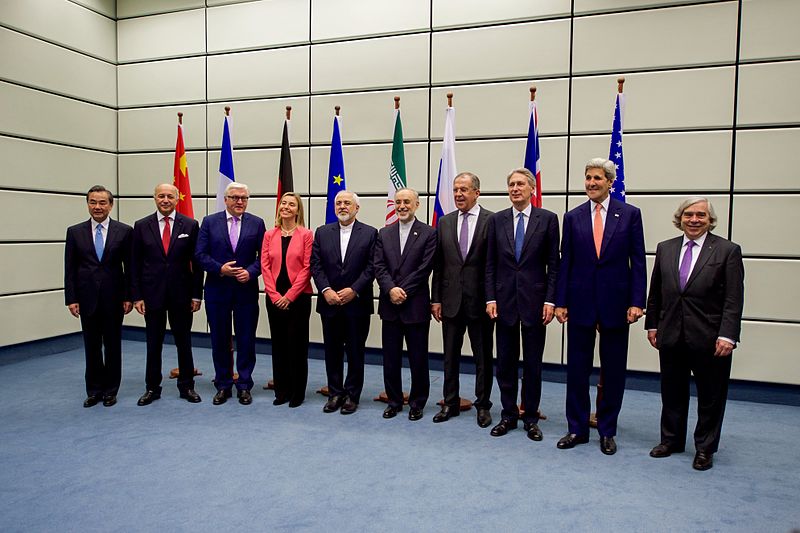Iran may be able to produce nuclear weapons “on demand”, a leading expert warned last week.
The report in The Economist magazine also provided details of a new nuclear facility being constructed by Tehran deep in the Zagros mountains.
It comes as the International Atomic Energy Agency (IAEA) has reportedly estimated that Iran’s stockpile of enriched uranium is now more than 23 times the level set by the 2015 nuclear deal (negotiations pictured).
Nukes “on demand”
- A team at the Washington DC-based Institute for Science and International Security, led by former weapons inspector David Albright, believe that Iran could produce enough weapons grade uranium for a nuclear weapon in 12 days, The Economist reported. Albright suggests Iran can thus produce nuclear weapons “on demand”.
- Their estimate is based on the latest quarterly IAEA report published in February.
- The institute says the 12-day timeline would require Iran to use half of its stock of 60 percent-enriched uranium. However, if it opted to use its entire stock of highly enriched uranium, Tehran could produce weapons grade uranium for four more nuclear weapons in a month. Two more weapons could follow in another two months if Iran used its stock of low-enriched uranium.
- While it might take Iran a couple of years to develop a ballistic missile to deliver a warhead, it would take only six months for it to produce a “crude delivery system”, like a plane or ship.
An invulnerable facility …
According to an analysis of recent satellite images prepared for The Economist by James Martin Centre for Non-proliferation Studies in California, a new nuclear facility is being built in the Zagros mountains, close to the Natanz enrichment site. The analysis suggests the facility is being constructed 80-100 metres deep below the ground and shows four entrances dug into the mountainside, each six metres wide and eight metres high. The US has developed a bunker-busting bomb, designed to destroy Iran’s underground Fordow nuclear site, which can travel 60 metres below the surface before detonating. The weapons factory in the Zagros mountains thus appears designed to be invulnerable to US attack. Experts believe Tehran may be planning to use the site to house a small number of advanced centrifuges.
… and a growing stockpile
IAEA reports estimate that, as of mid-May, Iran’s total enriched uranium stockpile was at 4,744.5kg (up from 3,760kg in February), according to the Associated Press. Of that, 114.1kg (up from 87.5kg in February) is enriched up to 60 percent purity, a short, technical step to weapons-grade levels. The 2015 nuclear deal limited Tehran’s uranium stockpile to 300 kgs (661 pounds) and enrichment to 3.67 percent, enough to fuel a nuclear power plant.
Case closed: two IAEA probes end
Confidential reports seen by the Associated Press indicate that the IAEA has ended two investigations into Iran’s nuclear programme.
- The first concerned the discovery of uranium particles enriched to 83.7 percent at the underground Fordow facility. The IAEA said its assessment was “not inconsistent” with Iran’s explanation – that the particles were an accidental by-product of its enrichment process.
- The second centred on traces of man-made uranium found at Marivan, near the city of Abadeh. Marivan has been consistently linked by experts to Iran’s secret military nuclear programme. Iran – which has repeatedly demanded the IAEA end its investigations as a prerequisite for any revival of the 2015 nuclear deal – said the uranium was produced by mining undertaken by “another [UN] member state” in the 1960s and 1970s. The IAEA called the answer “a possible explanation”, although the identity of the “member state” referenced by Iran is unknown.
- Israel reacted furiously to the news, saying the IAEA had yielded to Iranian political pressure. On Thursday, defence minister Yoav Gallant said Iran “may be required to fulfill our duty in order to protect the integrity of Israel and especially the future of the Jewish people”, echoing a warning from Benjamin Netanyahu earlier in the day that Israel “will do what it must to prevent Iran from getting a nuclear bomb”.
Talk, talk
Amid the worrying revelations, the Financial Times reported last week that President Biden’s special envoy for Iran, Robert Malley, has had several meetings with the Iranian ambassador to the UN – the first direct contact between US and Iranian officials since Donald Trump pulled out of the nuclear deal in 2018. Iran has refused to meet directly with the US in the Geneva talks which began in 2021 following Biden’s election. The US president wants to establish a “stronger, longer” nuclear deal. The Malley meetings have revived speculation that the US may be open to some form of “freeze for freeze” interim deal to reduce tensions. It might involve limited sanctions relief in exchange for Tehran freezing parts of its nuclear programme.
The ayatollah’s weapons for Putin …
On Monday, Sky News reported that it has seen a 16-page arms contract from September 2022 which provides the first hard evidence that Iran has sold weapons to Russia for Vladimir Putin’s war on Ukraine. The contract, which an informed security source labelled “100% authentic”, appears to be for samples of various types of artillery, tank shells and rockets and is worth just over £800,000. A further, apparently linked, contract seen by Sky for £590,000 included tank and artillery equipment, as well as ammunition shells. “It is our assessment that these were weapons ‘samples’ before further shipments,” the security source told Sky.
… and a UN leadership role
Last week, Iran was appointed as one of the vice-presidents of the UN General Assembly. At the same time, Tehran’s envoy, Heidar-Ali Balouji, was picked by the UN as the rapporteur of the Disarmament and Non-Proliferation Committee of the General Assembly and a member of the committee board. Last month, Iran’s UN ambassador, Ali Bahraini, was appointed to chair the UN Human Rights Council’s 2023 Social Forum, which will be held in November. Israel reacted to last week’s news, calling the decision “shameful”. The Ministry of Foreign affairs said: “In addition to murdering its own citizens, attacking innocents around the world and racing towards a nuclear weapon with the goal of wiping Israel off the map, Iran will now serve in a senior UN position.” The US also attacked the appointment.
What happens next
Closer to home, Wednesday will see a Westminster Hall debate in parliament on Iran, which is likely to focus on the British government’s continuing failure to proscribe Tehran’s ideological army, the Islamic Revolutionary Guard Corps. Labour has repeatedly pledged to ban the IRGC.



